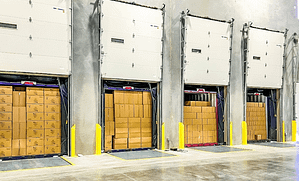The smooth and efficient movement of both goods and information is essential to the day to day operational success for any business. In the last several decades, warehouse management systems (WMS) have risen to prominence as the backbone of modern logistics and supply chain operations, revolutionizing the way businesses manage their inventory, storage, and distribution processes. Ensuring that products get to their destinations swiftly and accurately while managing the fidelity of order data is paramount. In today’s warehouses, a WMS is a critical part of a business’ technological infrastructure. In this article, we will break down what a WMS is, as well as the many benefits it offers to businesses.
What Is a Warehouse Management System?
A Warehouse Management System is a platform designed to optimize and streamline the operations of a warehouse or distribution center. It provides real-time visibility, control, and automation of various warehouse processes to improve efficiency, accuracy, and overall productivity. By leveraging a WMS, organizations gain greater control over their inventory, reduce operational costs, improve customer service, and ultimately boost their competitive edge in an increasingly demanding market. Today warehouse management systems are being used in 85% of warehouse operations. But what is the function of a WMS, and why is it so critical to a warehouse’s operations?
Warehouse Management System Functions
A WMS has large capability sets that greatly improve efficiency in all warehouse operations. Supported areas include:
Inventory Management
Inventory management in a WMS involves tracking the quantity, location, and status of all items within the warehouse. Each item is assigned a unique identifier, such as a barcode or Radio Frequency Identification (RFID) tag, which is scanned and recorded during various stages of its journey through the warehouse. The WMS ensures accurate record-keeping by updating inventory levels in real-time as items are received, stored, picked, and shipped. This real-time tracking prevents overstock or stockout situations, optimizing inventory levels to meet customer demand efficiently.
Picking, Packing, and Order fulfillment
With a WMS, picking, packing, and order fulfillment operations can be executed with precision. The system prioritizes orders, directing warehouse personnel to the exact location of items with guided picking instructions. The WMS can also generate shipping labels and even automate the creation of packing slips and invoices. This not only minimizes waste and shipping costs but also ensures the right items are packed.
Receiving
With real-time visibility, the WMS captures vital information about incoming goods the moment they arrive, including item specifics, quantities, and any batch or lot numbers. This automated data capture eliminates the need for manual entry, reducing errors and delays. In addition, the WMS excels in efficient space allocation by assigning precise storage locations for incoming items, optimizing the use of valuable warehouse space.
Storage Optimization
Effective utilization of warehouse space is crucial to minimize storage costs. WMS software strategically allocates products within the warehouse, ensuring that fast-moving items are easily accessible and slow-moving items are placed in less valuable storage locations. This maximizes the use of available space and minimizes the need for additional storage facilities.
Task Management
Task management features in a WMS assign and track various warehouse tasks, such as order picking, replenishment, and put-away. This ensures that all tasks are completed in an organized and efficient manner, optimizing labor resources.
Reporting and Analytics
The WMS can accumulate data on inventory levels, order fulfillment, labor productivity, and more. It then transforms this data into actionable insights using advanced analytics tools. Managers can access customizable reports and dashboards that offer real-time visibility into key performance indicators (KPIs) like order accuracy, on-time deliveries, and inventory turnover. These analytics empower informed decision-making, enabling businesses to fine-tune their operations, optimize inventory levels, and reduce costs.
Types of Warehouse Management Systems
Warehouse Management Systems can be categorized into different types based on their functionality and the specific needs of the business. Here are some common types of WMS:
- Standalone WMS: A Standalone WMS is an independent software system solely focused on warehouse management. It operates separately from other enterprise systems and is designed to streamline warehouse operations, including inventory tracking, order fulfillment, and warehouse optimization. While it doesn’t integrate with other supply chain or ERP modules, it offers robust functionality for warehouse-specific tasks.
- Supply Chain Modules: In contrast to a standalone WMS, Supply Chain Modules are part of a broader supply chain management software suite. These modules are designed to work together seamlessly, offering end-to-end visibility and control over various supply chain functions, including inventory management, transportation, demand planning, and warehouse management. Integration among modules enables efficient coordination and data sharing across the supply chain.
- ERP Integrated: This WMS is tightly integrated with an Enterprise Resource Planning (ERP) system. This integration ensures seamless communication between warehouse operations and broader business functions like accounting, order management, and procurement. ERP-integrated WMS solutions provide real-time synchronization of data, enabling accurate inventory management, order processing, and financial reporting within a single, unified system.
- Cloud-Based: A Cloud-Based WMS is hosted in the cloud rather than on-premises. It offers the advantage of accessibility from anywhere with an internet connection, making it flexible for remote management and scalability. Cloud-based WMS solutions often come with subscription-based pricing models, reducing the need for extensive IT infrastructure and maintenance.
Benefits of Using a WMS
The key benefits of implementing a WMS include:
- Improved Inventory Accuracy: Real-time tracking of inventory levels helps reduce errors and inaccuracies. It also helps minimize overstocking and stockouts, improving overall inventory management.
- Enhanced Efficiency: Streamlines processes such as receiving, picking, packing, and shipping, leading to increased productivity. Also optimizes warehouse layout and item placement for efficient order fulfillment.
- Increased Productivity: Provides tools for task assignment and workforce management, improving labor efficiency and reduces the need for manual data entry and paperwork.
- Cost Reduction: Reduces labor costs through efficient task allocation and automation. Optimizes inventory levels, minimizing carrying costs and storage expenses.
- Data Visibility and Analytics: Provides real-time visibility into inventory and operations data. It also offers analytics and reporting tools for informed decision-making and continuous improvement.
How Nautical Uses a WMS to Improve Efficiency, Visibility, and Overall Satisfaction for its Clients
Nautical leverages 3PL Central, a robust and versatile third-party logistics (3PL) software solution, to streamline and enhance our supply chain operations. Using 3PL Central, Nautical gains comprehensive control and visibility over our warehouse management processes, from inventory tracking and order fulfillment to labor management and reporting. This software platform empowers Nautical to efficiently manage our inventory, optimize storage space, and expedite order processing with precision. By utilizing 3PL Central’s advanced reporting and analytics capabilities, Nautical can make data-driven decisions, improving overall supply chain efficiency and customer satisfaction.
Warehouse Management System FAQ
What’s the difference between a Warehouse Management System vs Order Management System?
Warehouse Management System (WMS) and Order Management System (OMS) are similar software solutions used by warehouses, but the two have different functionalities. A WMS offers a comprehensive package that captures, records, and analyzes data on all day-to-day functions performed by a warehouse, an OMS only monitors the coming and going of all inventory throughout the supply chain for its entire lifecycle, including in the warehouse, and orders related to it.
What Does a WMS Do?
A Warehouse Management System is a software solution that efficiently manages and optimizes warehouse operations. It tracks inventory, facilitates order fulfillment, improves accuracy, and enhances overall warehouse efficiency through features like inventory tracking, order picking and packing guidance, real-time data updates, and reporting capabilities.
When Did WMSs First Become Popular?
Warehouse management systems (WMS) began to gain prominence in the late 20th century, particularly in the 1980s and 1990s, when advancements in technology allowed for more affordable and powerful computing technology. The increasing complexity of supply chains, globalization of trade, competitive pressures, and growth of e-commerce were other factors influencing the rise of WMSs.
Where Does a WMS Fit in the Supply Chain?
A WMS often works alongside or integrates with other systems like Enterprise Resource Planning (ERP), Transportation Management Systems (TMS), and Inventory Management Systems. Integrating and working with these other systems streamlines logistics, ensuring a smooth flow of information and goods across the supply chain.




